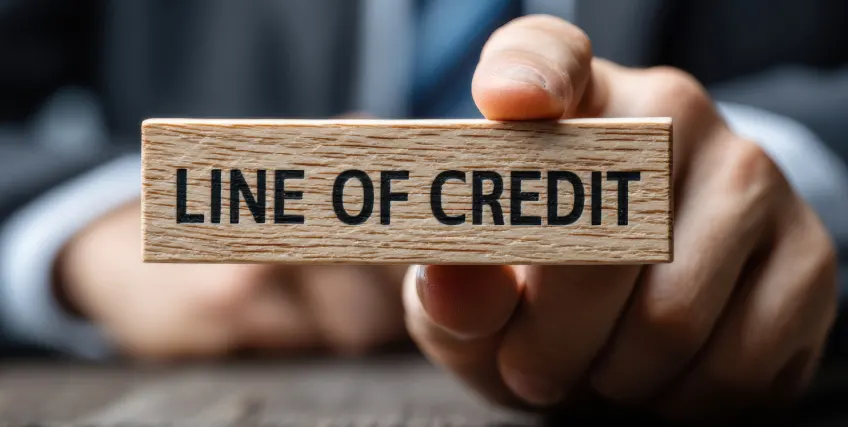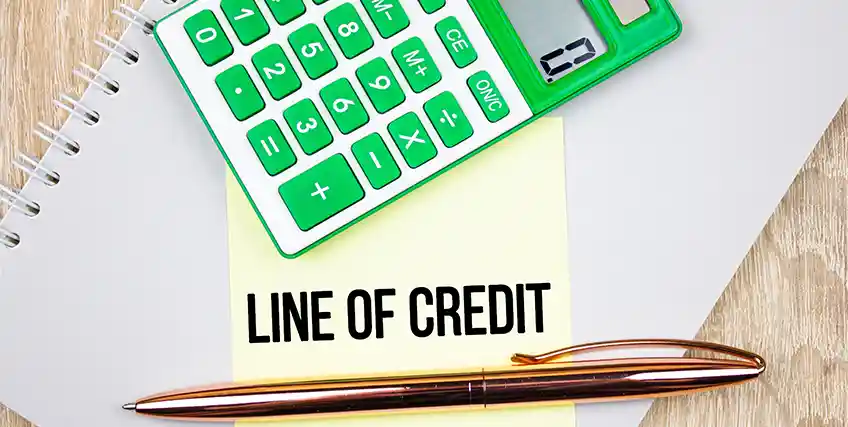Unlocking Growth: How a Business LOC Can Fuel Your Company's Success
April 22, 2025 | Last Updated on: April 22, 2025

Businesses count on cash flows from customers to pay bills, make payroll, and invest in their future. When customers take too long to pay their invoices business owners need extra cash to cover their expenses. When you get a business line of credit (LOC), you have easy access to cash when you need it, and you'll only pay interest on the money you use. As you repay your business LOC, you'll have extra spending power for future financing needs. Learn more about how an unsecured small business line of credit works, ways it can benefit your business, and how to get a business line of credit.
What is a Business Line of Credit?
A business line of credit or corporate line of credit — is an example of revolving credit. The lender gives the business a maximum credit line, which allows the business owner to spend up to a certain amount. The money can be used to finance capital expansion, buy inventory, pay bills, or protect against periods of low cash flow.
The line of credit may be linked to your business checking account to enable quick transfers to meet business needs. You may also set up automatic minimum monthly payments.
Repayment terms for your business line of credit are interest-only payments during your draw period. During this time, your monthly payment is based on how much you borrow, but you can always pay extra to reduce your balance. These accounts typically have variable interest rates whose pricing tracks the Prime Rate.
Some business LOCs are non-revolving lines of credit, which is similar to an installment loan. A non-revolving business LOC allows the business to borrow up to the principal amount of the loan. The loan is repaid in equal installments over the life of the loan.
Line of credit borrowing limits are typically smaller than a term loan, but they can go up to $250,000 or more. A line of credit also provides more flexibility than a loan because your interest charges and monthly payments are based on what you use. You can borrow from the business LOC repeatedly, whereas a term loan only provides a lump sum of cash once.
How Much Does a Business LOC Cost?
The cost of having a business LOC varies among banks. Some banks charge annual fees, while others do not. One of the biggest advantages of a business LOC is that you'll only pay interest on the amount you've borrowed. However, unlike a business credit card, there is no grace period. Your business LOC starts accumulating interest charges immediately.
A business LOC typically carries a variable interest rate, with rates ranging from 5% to 23%, depending on your creditworthiness. Banks usually set interest rates based on the Prime Rate, but some banks may use LIBOR or Treasury Bills to set rates. Interest rates on an unsecured business LOC are generally lower than a business credit card, but higher than a fixed-rate term loan.
Using a business LOC or a business credit card is a good way to help small businesses build a good credit profile. Businesses that start a small line of credit and pay off the debt as soon as possible can strengthen their credit rating and better position themselves for future financing. For companies considering a line of credit, it’s important to note that many lenders require that companies repay the full balance of the line annually or at other regular intervals. This is called “resting the line.”
Secured vs. Unsecured Lines of Credit
The most common classification of business lines of credit is based on whether a lender holds collateral (secured line) or not (unsecured lines). Since most banks require personal guarantees from small business owners, all lines of credit are secured even if there's not a specific asset tied to the business LOC.
Unsecured lines are based on the business owner's credit and the company's financials. A secured business LOC uses an asset as collateral. If payments are not made or the line of credit is in default, the lender can take the company to court to repossess the asset.
Since a secured business LOC has a lien on a specific asset, it poses less of a risk to the lender than an unsecured business LOC. Due to its lower risk, a secured business LOC may be larger or have a lower interest rate and fees.
Business Line of Credit Best Practices
Good personal and business credit are essential for credit approval of your business line of credit. The proven ability to generate a consistent cash flow is also key to getting approved for small business loans and lines of credit. When entering this arena, a sensible strategy is to apply for a lower line of credit and maintain a positive repayment history.
Responsible use of credit creates leverage for a business to access a large line later. Lenders are often reluctant to approve a business LOC during a recession or when the company is having financial troubles.
Qualifying for a Line of Credit
Most traditional lenders, such as banks, require businesses to have a strong history of annual revenue for a few years to qualify for a line of credit. Larger lines may require collateral. A strong credit score can also be a necessity for a business line of credit.
Here are six small business lines of credit requirements you need to know about.
Credit Score Requirements
Many lenders require a score of at least 670. For others, the minimum score required is 700. Having a score of 700 or above designates they have a lower risk of default.
Some lenders specialize in borrowers with bad credit. While it may be harder to get approved, it is possible to open a business LOC. However, you may be approved for a lower credit limit while paying a higher interest rate and having more fees on your account.
Industry Risk
There are cases where companies in certain industries as a whole can find it difficult to get financing through the loan process. For example, conventional lenders are hesitant to make small business loans to insurance agencies. This is because current financial records and assets don’t accurately reflect the potential value of a growing insurance agency.
Whether it’s to finance an upgrade in the agency’s operations, address issues with cash flow or fund an acquisition, an insurance agency line of credit can be a good option. Since banks are reluctant to issue credit to insurance agencies, an alternative lender may be an agency’s best option. The same challenges can apply to other industries, including restaurants, certain retail stores, construction companies, and the transportation industry.
Income and Assets
When reviewing a loan application, lenders typically focus on the borrower's income and assets to analyze their ability to repay the loan. Most banks want to see two consecutive years of operating profits and enough business assets to support the loan if annual revenues fluctuate.
In general, banks can provide financing for up to 50 percent of business assets. In addition to business financials and tax returns, applicants must typically provide personal financial information as well. This includes individual tax returns, bank account and investment statements, and other related documents.
If you want a fast business line of credit, consider applying with an online lender. While online lenders may have looser qualifications than banks, they may also offer lower credit limits. Loans and business LOC from these lenders may charge higher rates and fees.
To be considered for an easy business line of credit or loan, lenders typically require applicants to be in business for at least six months and have $25,000 in annual revenue. Business owners should have a FICO credit score of at least 500. However, some online lenders offer credit without checking your credit report. The higher your FICO credit score, the more likely you are to get approved for the best interest rates and loan terms on your business LOC or loan.
Financial Ratios
While there are numerous ways to evaluate the condition of your business, lenders typically focus on specific financial ratios the most when underwriting business LOC and loan applications. These are:
- Debt service coverage ratio (DSCR). Indicates if a company has sufficient income to pay the principal and interest of its debt.
- Fixed charge coverage ratio. Measures the ability of a company to pay the interest of its debt after paying its fixed costs.
- Current ratio. Measures the liquidity of a company and its ability to pay short-term obligations. This ratio is based on current assets and liabilities.
In addition, all lenders can also have their own additional underwriting criteria and ratios as part of their specific review process.
Guarantees
In addition to a guarantee from the company, most business LOC and loan applications require a personal guarantee from the company's owners. These guarantees may include material or financial assets of the business, as well as personal assets, like a home, bank accounts, and investments.
Secured lines of credit can use personal and corporate collateral to secure the repayment of a loan should the business default on payments. In this scenario, a lender can foreclose on these assets. Collateral such as real estate, account receivables, inventory, equipment, securities or savings accounts may be used.
Lenders typically file a UCC line or similar instrument against the pledged assets to secure their interest in the asset. Unsecured lines don’t involve the use of specific assets to secure credit. In the absence of pledged assets, company and personal guarantees allow the bank to sue a company – and its owner personally – in case of default. Should a lender win such a lawsuit, it could foreclose on the company's assets and its owner's personal assets.
Personal Background and Credit Search
In addition to checking your personal credit history, lenders may also perform background checks on business owners and their associates. This involves investigating their personal and professional histories, as well as the assets and liabilities of those associated with the business.
This in-depth search allows lenders to assess the character of those involved in a business. It helps filter out business owners who lack great credit, have few assets, or borrowers who have troublesome personal traits. For example, these searches may uncover gambling issues or drug use that could compromise the viability of a company.
Business LOC Covenants
Not only must you make your business LOC payments on time, but you must adhere to loan covenants imposed by the lender. These covenants are conditions a company must comply with to keep its line of credit open.
While loan covenants vary by lender, here are some of the typical covenants a business owner can expect:
- Net Worth. Companies can be expected to maintain a minimum net worth. This mandate protects lenders from having a company’s assets drop too low, which could jeopardize the recovery of their funds.
- Monthly Certification. Business lines of credit may need to go through a monthly certification process. This requires the company to disclose the current state of its accounts, inventory and other assets. The availability of funds is tied to the assets listed in such a certification.
- Confession of Judgement Clause. This clause allows the bank to file a judgment without going through a trial. This clause enables lenders to expedite their collection efforts before the borrower can deplete their bank accounts or other valuable assets.
- Lenders may stipulate that a company comply with the minimum standard of various liquidity ratios. Ratios may include the current ratio, the quick ratio, or the cash conversion cycle.
- A company may be required to perform above certain minimums for the debt service ratio, the fixed charge ratio, and similar ratios.
- Material Changes. This is a clause that covers a wide variety of issues that can negatively affect a business but aren’t specified in other covenants. For example, if the owner sells part of the business, a partner sells their equity, or a critical employee or customer leaves the company.
Business Lines of Credit: Pros and Cons
As with any lending instrument, there are advantages and disadvantages to a business line of credit.
Pros
The most attractive aspects of a line of credit are:
- Rapid improvement of cash flow;
- Flexibility if the business stays under the credit limit;
- Ability to pay for important and emergency expenses;
- Less expensive than alternate solutions.
Cons
Of course, lines of credit also have drawbacks, just like any funding solution. Among the most notable are:
- Difficult to qualify;
- Covenants can be hard to abide by;
- If the limit is reached, it can be problematic to increase it quickly;
- Startups or companies with less than two years of operation are ineligible;
- Purchase orders cannot be considered collateral.
Alternatives to a Business LOC
Eligibility for a business LOC can be difficult for startups and small, growing companies. While Small Business Administration lines of credit, such as an SBA 7(a) loan, may be easier to get than conventional financing, they can still be inaccessible for a small company.
Fortunately, alternatives for financing are available for these companies. Here are a few examples:
Invoice Factoring
One of the easiest business lines of credit to get is invoice factoring. Lenders use your customer invoices to secure the debt, so they will collect from your customers if you don't pay on time.
Commercial clients typically take 30 to 60 days to pay their invoices, which causes low cash flow in many companies. As a result, they run the risk of being unable to pay their expenses. Invoice factoring lets you finance these slow-to-pay accounts receivable and receive working capital immediately.
The business gets funds directly from the factoring company. Once the invoice is paid by the client, the transaction is over.
Purchase Order Financing
Rapidly growing businesses are not ideal candidates for a business LOC since they can quickly reach their credit limit. If the business accumulates more purchase orders than it can handle financially, getting a lender to increase the limit is a lost cause because lenders don’t consider purchase orders to be assets.
A purchase order funding line pays for supplier expenses directly associated with a purchase order. This allows a business to book and fulfill large orders that it couldn’t handle without help.
Asset-Based Lending
Asset-based lending is a potential credit solution for larger companies. An asset-based line can help finance assets such as accounts receivable, inventory, machinery and real estate.
Companies that don’t qualify for a business LOC or cannot comply with financing covenants can benefit from this solution. Asset-based lines use existing assets like receivables inventory to work like revolving lines of credit.
The credit limit of the business can increase quickly, but only if the company has accounts receivable and other assets to support it. As such, asset-based lines can be a good option for small businesses that are growing quickly.
Line of Credit Business Loans
The Small Business Administration (SBA) offers loans and a business LOC under the SBA 7(a) loan program. These loans provide up to $5 million for short-term working capital needs. These loans aim to help businesses take on more public and private contracts and purchase orders.
With a business LOC, funding can be used as often as it’s repaid. Interest rates for SBA CAPLines typically range from 5% to 10% but vary by lender and your creditworthiness. The SBA itself doesn’t issue the CAPLines itself. Instead, it provides loan guarantees that enable lenders to issue financing to companies that may not qualify for traditional bank loans.
The Bottom Line
Getting a business line of credit for your business is essential for your everyday business needs. A business LOC is a flexible form of financing with a fixed credit limit. You can use the line of credit repeatedly to borrow as you need it and repay when you can. With a variable interest rate and interest-only payments based on how much you borrow; it offers affordable payments to help your growing business.
Frequently Asked Questions (FAQs)
Is it Hard to Get Approved for a Business LOC (line of credit)?
Companies can get approved for a business LOC based on their company financials, personal credit scores of the owners, and their ability to repay the loan. Although lenders typically like to see credit scores above 700, some online lenders may approve business owners with credit scores as low as 500. SBA loans are another option for startups and borrowers with low credit scores.
Is a Business LOC a Liability?
Yes, the business line of credit is a liability on your company's balance sheet. The amount of the liability depends on how much you borrow. As you repay your balance, its negative impact on your balance sheet diminishes. Effective use of your business LOC can help your business grow and increase your equity.
Can You Use a Business LOC for Anything?
Most lenders do not restrict how a business uses the line of credit. Business owners typically use the business LOC to make short-term purchases of inventory, pay bills, or cover payroll. If you're buying an asset with a longer lifespan, consider using a Term loans or lease that matches its useful life.
Can an LLC Get a Business Line of Credit?
Yes, a business LOC is available for all types of businesses, even a limited liability company (LLC). Lenders typically require personal guarantees from all managing partners when applying for your line of credit.




